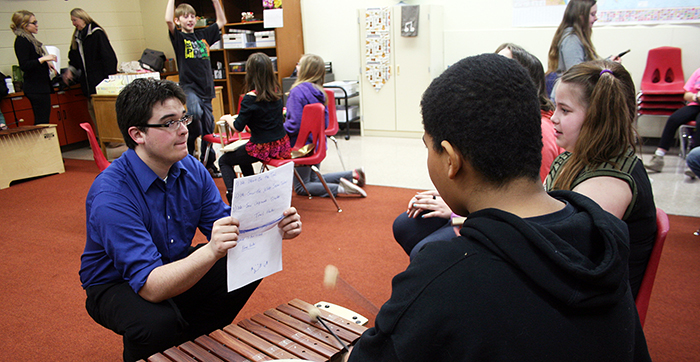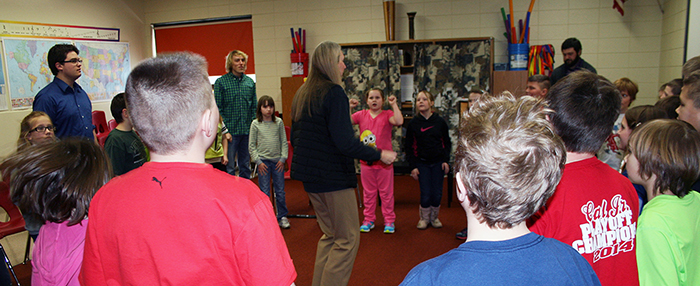
Have you ever wondered about what can happen when schools and higher learning institutions work together to serve the educational needs of their students?
An important aim of 21st-century education is to develop classroom environments that are “communities of learners” – where educator and students work and learn together for the greater good of all. At the University of Wisconsin-Superior, under a “learning community” model of fieldwork, music education majors have opportunities to prepare for their chosen career by engaging in teaching and learning in general and choral music education in the schools.
Under this unique model of “learning through experience,” school educators, children, and youth in schools, higher education students pursuing degrees in music education and I work together as a community of learners. Under this model, the pre-service educators progress through a series of levels of educator responsibilities, from participant-observer to lead planner-educator.
Collaboration
Young students engage with the higher education students in a variety of programs, including:
- Integrated 4K music education
- Interdisciplinary creative writing and composing projects with 5th graders
- Interconnected national standards teaching and learning in soprano recorder with 4th graders
- Afterschool composition clubs for middle school students
- Superior Community Youth Choir for 4th and 5th graders
- Collaborative concerts with 4th-12th graders, university faculty and staff and community adults
All programs are without cost and open to all students in the targeted age groups at the schools.
Many of the above-mentioned program designs are formulated under the framework of Academic Service-Learning (ASL) – one of the High Impact Practices in place at the University of Wisconsin-Superior that support its mission. Through ASL, synthesis of theory and practice are realized through real-life field experiences whereby higher education students have the opportunity to apply and further develop skills and understandings that are part of course content experienced in the university classroom.
At UWS, I also use this model with higher education students who are seeking degrees in elementary classroom education. In this case, the model is applied to integrated and interdisciplinary learning community models of music education.
Developing Hands-on Competencies in Teaching and Learning in Music
During the various field experiences at the teaching and learning sites, higher education students develop:
- Hands-on skills and understandings in how to plan, carry out and assess sequentially ordered, interconnected instruction in music
- Strategies for navigating and facilitating whole group and small group learning
- Classroom management
- Experience in how to plan and carry out integrated instruction: music with other arts and subjects
After my initial design of the program, and context building and teaching on the first day of the fieldwork, higher education students work in pairs and small groups to engage children and youth in music instruction and musical experience. The school educator and I work alongside the pre-service educators helping or facilitating when needed. To develop understanding through experience, university students are provided with many opportunities for planning and carrying out teaching and learning, and progress quickly through several levels of involvement to lead-planner educators at the site.
Reflection
A valuable aspect of this kind of field teaching experience is the opportunity for individual and whole group reflection. Throughout the duration of the fieldwork, after conducting teaching and learning at the site, students meet in their university classroom to:
- Discuss daily happenings and any feedback received from the school educator
- Receive and discuss feedback from their professor and peers
- Continue the planning process making accommodations and modification as necessary according to the daily experiences with the children or youth at the teaching and learning site.
Again, I view the opportunity to be at the site with my students – in the classroom every day – as a critical advantage to their growth and understanding. It is this collaborative aspect – working together as educators, and then reflecting on the experience and continuing the planning process together – that helps to make this program effective.
After each site visit, I use inquiry to engage the higher education students in thinking about their experience that day. Everyone takes part in the discussion and contributes feedback and ideas for moving forward. This helps inexperienced educators to learn how to think through the processes of planning and carrying out instruction and to think about viable ways to assess student learning.

Authentic Learning through Experience
Over the course of two semesters of general music methods courses, 5-6 multi-day projects are conducted to provide the pre-service educators with teaching experience in a variety of age groups. All project goals and outcomes are based on the curricular needs of the school educator and align with the learning goals and outcomes of the higher education methods course and degree program goals.
Some programs fulfill a curricular need that is more easily met by small group learning with 1-2 educational facilitators. For example, small group composing with elementary and middle school age children. The collaboration between K-12 school classrooms and university pre-service general music education methods courses is perfect for a variety of programs in this model.
Because most of the field teaching experiences are conducted in general music classrooms or as school-site programs (where all children participate), this model of fieldwork offers higher education students authentic teaching and learning experiences in authentic contexts.
For programs scheduled outside of the regular school schedule, families in the school are notified that all children are encouraged to attend. There are no required auditions or fees. The goals are to offer additional opportunities for music education for all children or youth who have the desire or interest to participate, to support the music education programs in the school, and to support pre-service music teacher education.
First Steps in Finding a Partner
Whether collaboration is first sought out by a school educator or a higher education educator, procedural guidelines can help to “get the ball rolling” and to determine whether or not a partnership is a good fit that will benefit everyone involved.
Educators interested in finding similar partnerships could begin by:
- Determining curricular needs of your students.
- Setting up appointments with key individuals in potential program partnerships. At the onset, make sure that scheduling a collaborative project is possible.
- Through discussion with potential partners, determining goals and needs of their students by asking what would support their curricular goals and needs.
- As a point of departure for determining a mutually beneficial project or program, prepare a list of the kinds of programs you and your students could provide in a partnership, and/or a list of the kinds of programs you and your students seek. This can provide some idea of what might be possible for even a brand new program design.
Create a Partnership and Plan
To create a successful partnership or plan, educators can:
- Brainstorm and plan with all participating partners, or design a program around the partner’s curricular needs and your students’ learning needs.
- Send a draft of the plan to the key person in the collaboration and others if necessary for their feedback and/or approval.
- Modify the plan according to feedback.
- From the plan, prepare a syllabus, and if the program is to be designated as an ASL program, submit the syllabus for approval from the ASL Center at the university or partnering school.
- Provide the syllabus and an outline of responsibilities for all of the educators and pre-service university educators.
Next Steps
Some of the necessary additional details educators should be aware of include:
- Providing partners with any legal forms necessary, and obtaining signatures. Work with the partner to provide letters of information and/or permission to participate slips for parents of young students. In some universities, if there is an ASL center, ASL staff might be able to help with these matters.
- If you are the main designer/director of the collaboration, sending schedules to all partners and higher education students.
- Preparing a detailed plan for each site visit that includes pertinent information regarding the goal for that day; the order of events; a list of any necessary materials; and duties of all involved. As the pre-service educators progress in their learning throughout the program, turning over more and more of the responsibilities for planning and leading until the students are ready to serve as “lead planner and educator” at the site. The pre-service educators can take turns as lead planner-educator in continuing the sequential teaching and learning.
- In advance of a start date, scheduling meetings or seminars with school and university student educators to go over the syllabus, purposes of the project, an outline of designated duties and procedures, and in some cases, to go over materials and/or to practice the pedagogy that will be used during the program.
Goals/Benefits
Among the overarching goals and benefits of this approach are to:
- Support the community partners’ curriculum and learning goals for their students or clientele.
- Provide the pre-service educators with applied experiences in authentic contexts of their chosen profession that support the development of skills, understandings and know-how they will need in their future teaching.
- Provide the community partner’s students with rich teaching and learning in whole and small group collaborative experiences in music education that support lifelong engagement in music.
- Promote and experience the value of collaborative civic engagement.

Participant Response
“I found my time in the local schools a very useful first step towards being a teacher and one of the best experiences in my degree program for learning how to plan lessons and carry out instruction. Not only did this benefit us with teaching experience as a thoughtful preparation for student teaching, but I feel it also benefitted the surrounding community.” – Charles Corbett, Choral-General Music Education Major
“In my opinion, this is the best kind of ASL field teaching experience. It was invaluable to observe my professor put into practice the various teaching strategies and to watch the children respond to those methods. It was also incredibly exciting to participate in and observe my peers’ lesson plans. That gave us an opportunity to see the many creative ways in which we could integrate the subject matter into our own future classrooms. The best part of the experience, that I felt was most beneficial, was the immediate feedback and guidance we were given after submitting lesson plans and directly after teaching the lesson. The professor was able to observe us and guide us during this type of experience that was extremely helpful. In class, we were able to focus on the material we were learning and also reflect on our experiences teaching.” – Lindsey Dobson, Elementary Education Major
“This has been a win-win collaboration for us.” Everyone benefits. The win-win learning was for all – young to old – students, teachers, principal, and families.” – Mark Howard, Lake Superior Elementary School Principal
Planning for such programs can be time-consuming, however, the outcomes can be well worth the efforts for everyone involved in the project. Readers interested in more information are invited to review my recent NAfME article and chapter contribution to the SAGE publication, “SAGE Sourcebook of Service-Learning and Civic Engagement.”
[Article copyright 2017, Lois Veenhoven Guderian]